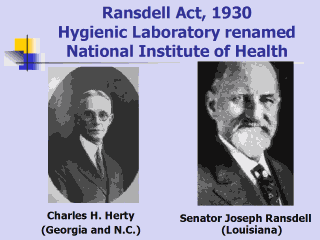 |
World War I was
known as the "chemistís war." The use of poison gas by the German forces led
the U.S. military to reconsider its decision that science was not needed in
warfare. A Chemical Warfare Service brought together scientists from around
the nation to develop gas masks and antidotes to gas attacks. After the war,
Dr. Charles Holmes Herty, who had been president of the American Chemical
Society during the war, proposed the creation of an "Institute for
Chemotherapeutic Research," to bring the benefits of chemical research to
medicine. By 1926 he and his associates despaired of finding a private
patron for this institute, and Herty joined with Louisiana Senator Joseph
Ransdell to seek legislation for federal funding. Four years later, in May
1930, the ambitious original plan for $15 million had been cut back in
accordance with economic depression to $750,000 for one building. No new
institute was created, but the existing Hygienic Laboratory was renamed
"National Institute of Health," which Ransdell thought was a more appealing
name. The Ransdell Act also provided that the NIH could accept donations to
fund fellows training in chemical research. |
